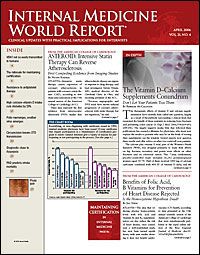Publication
Article
As Polio Makes a Comeback, Another Rare Virus Emerges in the United States
Author(s):
When a World Health Organization (WHO) initiative was successful in reducing the number of polio-endemic countries from 125 in 1988 to 6 in 2003, it seemed that polio was destined for the history books. Now the Centers for Disease Control and Prevention (CDC) has recently announced that during 2002 to 2005, wild poliovirus (WPV) type 1 had spread from the 6 remaining polio-endemic countries to 21 previously polio-free coun?tries (MMWR. 2006;55: 145-150) (Figure).
WPV was imported directly from Nigeria into 11 African countries, causing anywhere from 1 case per country up to a high of 44 cases in Chad. Virus from the Chad outbreak then spread to Sudan and into the Arabian Peninsula and Indonesia. In 13 of the 21 previously polio-free countries multiple-case outbreaks occurred, lasting at least 6 months, including 478 cases in Yemen, 299 cases in Indonesia, 154 cases in Somalia, and 146 cases in Sudan.
The transmission of WPV had been stopped or significantly slowed in all 21 countries, except Somalia, by the end of 2005. However, during the last half of 2005, sustained transmission was reported in 5 countries (ie, Angola, Ethiopia, Indonesia, Somalia, and Yemen) and in Nepal, which has been struck with repeated importations.
The CDC blamed the WPV importations on the cessation of immunization campaigns in northern Nigeria between 2003 and 2004, coupled with funding restrictions that led to countries stopping polio immunization campaigns after becoming polio free.
The outbreaks were fed by inadequate response vaccination; only 6 of 20 countries followed the recommendations and began response vaccination within 60 days of confirmation of the initial imported cases.
The WHO recommends that polio-free countries that detect an imported case immediately institute the following procedures:
? Implement risk assessment and prepare a vaccination response plan within 72 hours
? Conduct >=3 house-to-house immunization campaigns within 28 days
? Immunize at least 2 million to 5 million children aged <5 years in affected and adjacent areas
? Begin independent monitoring to en?sure adequate coverage.
In another report, the CDC recently described 4 cases of orf virus infection occurring between 2004 and 2005 in New York, California, Illinois, and Tennessee (MMWR. 2006;55:65-68).
Infection with the orf virus, a zoonotic parapoxvirus, is an often benign condition characterized by skin lesions that can easily be confused with life-threatening infections, such as cutaneous anthrax.
Although the infection is self-limited in immunocompetent hosts, immunocompromised patients may require antiviral therapy and surgical debridement for progressive, destructive skin lesions. Physicians should be aware of the following main points about orf infection:
? Orf infection is facilitated by skin trauma, including trivial injury
? The history usually includes contact with infected or recently vaccinated sheep or goats (but not contact with rabbits as in tularemia or contact with swine and sylvan rodents as in erysipeloid)
? Only testing with polymerase chain reaction can provide the definitive diagnosis
? Barrier precautions and proper hand hygiene can prevent further spread
? Farm workers can prevent infection by wearing gloves and using proper hand hygiene.






